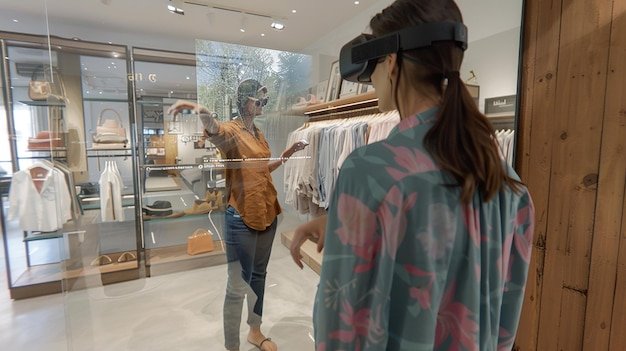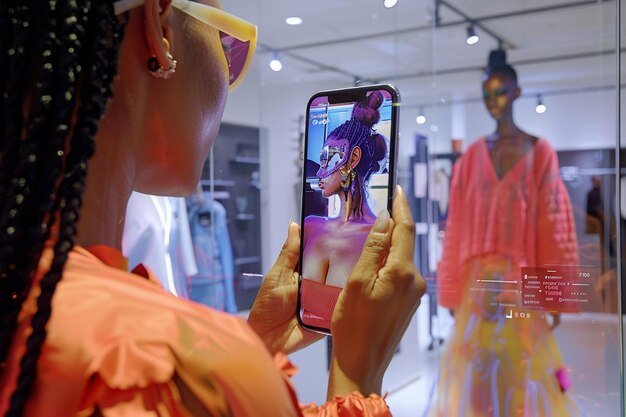Personalized Shopping USA 2025 will be defined by AI-driven recommendations, augmented reality try-ons, and seamless omnichannel experiences, enhancing customer engagement and driving sales growth.
Imagine walking into a store where every product is curated just for you, or browsing online and instantly finding exactly what you need. That’s the promise of personalized shopping USA 2025, and it’s closer than you think.
The Rise of Hyper-Personalization
Hyper-personalization is no longer a buzzword; it’s becoming the standard in retail. By 2025, US consumers will expect a shopping experience tailored to their individual preferences, purchase history, and even real-time behavior.
This shift is driven by advances in artificial intelligence (AI) and machine learning (ML), which enable retailers to analyze vast amounts of data and create highly targeted offers and recommendations.

AI-Powered Recommendations
AI algorithms will be instrumental in delivering personalized recommendations across all touchpoints, from email marketing to in-store displays.
- Predictive Analytics: Anticipating customer needs before they even arise.
- Dynamic Pricing: Adjusting prices based on individual customer behavior and market conditions.
- Personalized Content: Delivering relevant product information and promotions based on customer preferences.
These technologies will not only enhance the shopping experience but also drive significant increases in sales and customer loyalty.
In conclusion, AI is set to revolutionize retail by providing deeper personalization and targeted offers.
Augmented Reality (AR) and Virtual Reality (VR) Shopping
Augmented reality (AR) and virtual reality (VR) technologies are poised to transform the way consumers shop in the US. By 2025, these immersive experiences will become more commonplace, offering shoppers new ways to interact with products and brands.
Imagine trying on clothes virtually from the comfort of your home or visualizing furniture in your living room before making a purchase. AR and VR make these scenarios a reality.
Virtual Try-Ons
AR-powered virtual try-ons will allow customers to see how products look on them in real-time, enhancing the online shopping experience and reducing returns.
- Cosmetics: Trying on makeup shades virtually.
- Eyewear: Seeing how different frames look on your face.
- Clothing: Virtually trying on outfits before buying.
This technology will not only improve customer satisfaction but also reduce the environmental impact of returns.

Immersive Shopping Experiences
VR will create immersive shopping environments that transport customers to virtual stores, showrooms, and even fashion shows.
These experiences will be particularly valuable for high-end and luxury brands, allowing them to showcase their products in a unique and engaging way.
AR and VR are set to redefine retail by offering interactive and immersive shopping experiences.
Omnichannel Personalization
The future of personalized shopping in the US lies in seamless omnichannel experiences. By 2025, consumers will expect a consistent and personalized experience across all channels, whether they’re shopping online, in-store, or on their mobile devices.
This requires retailers to integrate their data and systems to create a unified view of the customer, enabling them to deliver personalized offers and recommendations regardless of how the customer chooses to shop.
Data Integration and Customer Profiles
Retailers will need to invest in data integration and customer profiling tools to create a comprehensive understanding of each customer’s preferences and behaviors.
This will enable them to deliver personalized experiences across all channels, from targeted email marketing to in-store recommendations.
Personalized In-Store Experiences
In-store experiences will become more personalized, with technologies like location-based marketing and personalized displays.
For example, a customer might receive a personalized offer on their mobile device as they enter a store, or see a personalized product recommendation on a digital display based on their past purchases.
Omnichannel personalization is essential for creating a seamless and engaging shopping experience in the US market.
| Key Aspect | Brief Description |
|---|---|
| 🤖 AI-Driven Personalization | AI algorithms analyze data to provide tailored product recommendations and dynamic pricing. |
| 👓 AR/VR Shopping | Augmented and virtual reality offer immersive shopping experiences, such as virtual try-ons. |
| 🛍️ Omnichannel Integration | Seamless customer experience across all channels, integrating data for personalized offers. |
| 🎯 Predictive Analytics | Using data to anticipate customer needs and personalize shopping experiences. |
Conclusion
As we look towards 2025, personalized shopping in the USA is set to become even more sophisticated and integrated into our daily lives. By leveraging AI, AR/VR, and omnichannel strategies, retailers can create shopping experiences that are not only convenient but also deeply engaging and tailored to individual preferences, driving customer loyalty and sales growth in an increasingly competitive market.

Deixe um comentário